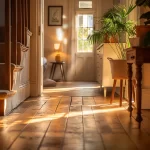In the enchanting world of old houses, from Georgian elegance to Edwardian grandeur, lies a common adversary: damp. This article delves into the realm of easy damp proofing ideas tailored for historical buildings, navigating through the nuances of maintaining structural integrity while preserving their timeless beauty.
We’ll explore the types of damp, their underlying causes, and effective strategies for prevention and care, offering a bridge between past craftsmanship and present-day living. Join us in safeguarding these architectural treasures, ensuring they remain not just standing but vibrant homes for generations to come.
Damp Proofing in Historic Homes
Old houses, particularly those constructed before the 1940s, from the Georgian to the Edwardian eras, possess a unique charm and historical significance that many homeowners and property managers cherish. These structures, often celebrated for their architectural integrity and aesthetic appeal, were built using breathable materials and employed traditional damp-proofing methods such as slate, bitumen, and hessian.
However, with the evolution of building technologies, there has been a transition towards modern chemical and membrane damp proof courses (DPCs). This shift, while innovative, has introduced challenges in maintaining the delicate balance between preserving the historical essence of these buildings and ensuring they are livable and structurally sound.
The Challenge of Dampness in Historical Buildings

The silent adversary lurking within the walls of historic buildings is often damp—a condition that stealthily undermines the structural integrity and aesthetic charm of our cherished architectural heritage.
Contrary to popular belief, the prevalence of damp in these age-old edifices is primarily the result of condensation, inadequate ventilation, and the breakdown of once-effective waterproofing systems rather than the frequently cited phenomenon of “rising damp.” These venerable structures, constructed with materials designed to “breathe,” find themselves at odds with certain modern renovation practices. These practices, while well-intentioned, can inadvertently seal off the building’s natural ventilation pathways, trapping moisture within and exacerbating damp issues.
This intricate dance between preserving historical authenticity and adapting to contemporary living standards calls for a nuanced approach to damp proofing. It is a delicate balancing act that requires a deep understanding of the building’s original construction techniques, an appreciation for the materials’ inherent properties, and a thoughtful integration of modern damp-proofing solutions.
Understanding Types of Damp and Their Causes
Damp in historical buildings is not a singular issue but a complex interplay of various factors, each with its unique origins and challenges.
- Condensation and ventilation issues, for instance, stem from the modern lifestyle’s demand for sealed environments, often clashing with old structures’ need for airflow. This results in moisture accumulation, particularly in spaces where renovations or modern living habits, such as blocked fireplaces or sealed windows, obstruct natural ventilation.
- Penetrating damp takes root in the physical vulnerabilities of a building—cracks in walls, faulty roofing, or compromised joinery—allowing rain or groundwater to infiltrate the fabric of the building. These breaches in the building’s exterior demand vigilant maintenance and prompt repair.
- Lastly, the phenomenon of rising damp—though less common than perceived—is attributed to the capillary action of water from the ground, ascending through porous building materials. This issue underscores the importance of an intact damp-proof course or the need for its introduction in buildings lacking one.
Each type of damp presents a unique puzzle, requiring a tailored approach to diagnosis and treatment. Understanding the specific nature and cause of dampness is crucial in devising effective strategies to preserve the structural and aesthetic integrity of historic buildings, ensuring they remain healthy and habitable for years to come.
Strategies for Effective Damp Proofing
Effective damp proofing in historical buildings hinges on a cornerstone principle: maintaining the breathability of construction materials. This approach respects the inherent design and materials of old structures, which were originally conceived to allow moisture to evaporate naturally from their walls.
To achieve this, a multifaceted strategy is essential. Ensuring proper ventilation is paramount; it involves not only unblocking original airways, such as chimneys and vents, but also integrating discreet, modern ventilation solutions that align with the building’s aesthetic and structural integrity.
Moisture management extends beyond ventilation, requiring proactive measures to control internal humidity levels—this might include the use of dehumidifiers or smart heating solutions that maintain a consistent indoor climate.
The selection of materials plays a critical role; for repairs or renovations, it’s vital to choose materials that are compatible with the building’s original fabric. Lime plaster, for example, is often preferred over cement in older buildings due to its porous nature, allowing walls to “breathe” and moisture to escape.
These strategies, when applied thoughtfully, can effectively mitigate damp problems, preserving the structural health and historical value of old houses while ensuring they remain comfortable, livable spaces.
Professional Assessment and DIY Solutions

Navigating the intricate landscape of damp proofing requires a blend of expert intervention and practical, hands-on approaches. Professional assessments play a pivotal role in accurately diagnosing the type and extent of dampness, leveraging sophisticated tools such as moisture meters and hygrometers. These instruments allow specialists to pinpoint moisture origins and concentrations, crafting precise and effective treatment plans.
Beyond professional diagnostics, there lies a realm of DIY solutions accessible to homeowners. Simple yet impactful measures like improving natural ventilation by ensuring windows and vents are clear of obstructions or introducing mechanical ventilation in areas prone to high humidity can significantly mitigate damp issues.
The application of water-repellent sealants to vulnerable exterior walls and the installation of drainage solutions to redirect water away from the building foundation are other effective strategies that homeowners can undertake.
These DIY efforts, when combined with professional advice and interventions, create a comprehensive damp-proofing strategy. This dual approach not only addresses immediate damp problems but also fosters a proactive culture of maintenance and care, which is essential for the preservation of historic homes.
Prevention and Ongoing Care
The battle against damp in historical buildings is ongoing, requiring vigilant prevention and consistent care to safeguard their structural health and aesthetic beauty. A crucial component of this preventive strategy is the enhancement of exterior water management. This involves not only maintaining gutters and downspouts to ensure efficient water diversion away from the building’s foundation but also landscaping that directs water flow away from the structure.
Sealing potential moisture entry points is another line of defence, which includes addressing cracks in walls, faulty windows, or deteriorating mortar joints that could invite water ingress. The strategic placement of moisture barriers in critical areas can further fortify a building against damp, preventing ground moisture from rising into walls and floors.
Ensuring adequate heating within the building helps to maintain a consistent internal climate, reducing the likelihood of condensation by balancing indoor humidity levels. Moreover, regular monitoring of moisture levels within the structure, coupled with periodic inspections for structural integrity, allows for the early detection of potential issues, enabling timely interventions.
This comprehensive approach to prevention and ongoing care not only mitigates the risk of damp but also preserves the heritage and livability of old houses for future generations.
The Importance of Education and Professional Consultation

In the quest to protect and preserve historical buildings from the ravages of damp, the role of education and professional consultation cannot be understated. A well-informed homeowner is empowered to make decisions that align with the long-term health and heritage of their property.
Understanding the nuanced causes of damp, beyond the common misconceptions lays the foundation for effective intervention. This knowledge demystifies the complex interplay between building materials, environmental factors, and historical construction techniques, guiding property owners in recognising signs of damp early and responding appropriately.
Professional consultation offers a critical next step, connecting theory with practice. Specialists who are PCA-approved (Property Care Association) and hold CSTDB (Certificated Surveyor in Timber and Dampness in Buildings) qualifications bring a level of expertise and understanding that is indispensable for historic buildings. These professionals not only diagnose damp issues with precision but also design treatment plans that honour the building’s architectural integrity.
By advocating for the use of appropriate, breathable materials and conservation-friendly techniques, they ensure interventions that are sympathetic to the original fabric of the building. Engaging with such specialists fosters a collaborative approach to damp proofing, one that educates and empowers property owners while safeguarding our architectural heritage against future damage.
“As a professional damp surveyor, I cannot stress enough the importance of expert consultation in both preventing and treating damp. Each historical building presents its own unique set of challenges, and there’s no one-size-fits-all solution. By combining thorough diagnostics with a deep understanding of traditional construction, we tailor strategies that respect the building’s heritage while effectively addressing damp. Engaging with specialists early can save not only the structural integrity of your property but also its soul.” – Phil Donno, London Damp Treatments.
Preserving Our Heritage
The essence of damp-proofing old houses lies in a respectful balance between preserving their historical value and ensuring their suitability for modern living. By adopting informed, careful approaches to damp proofing, we safeguard these treasures for future generations, maintaining their beauty and structural soundness.







